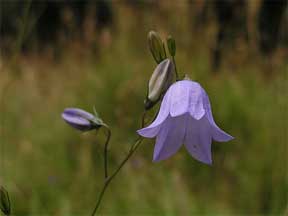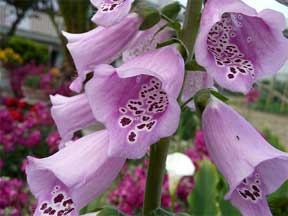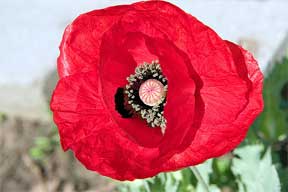Some gardeners feel that it’s hardly worth while bothering with biennials. Nevertheless, this much neglected group of flowering plants lends variety and interest to the garden panorama, and helps provide a continuous succession of bloom, so essential in the well-planned landscape.
What would we do without the happy, flouncy Canterbury bells, the showy foxgloves, or even the old a familiar hollyhocks?
All in all, biennials are useful forms that need not be shunned because of their somewhat “temporary” nature, but employed and enjoyed for what they do have to offer. Most of them are easy to grow, and many have flowers suitable for cutting.
A True Biennial
A true biennial is a plant which blooms the second year from seed and then dies, having produced only a rosette of leaves the first season. Believe it or not, most of the garden flowers we call “biennials” are really short-lived perennials which do best when started from seed the previous summer or fall.

A good example is the colorful sweet William which, although usually handled as a biennial, very often lives for three or more years under good conditions. The English daisy, another true perennial, also gives its best performance when seeded in late summer and over-wintered for blooming in early spring.
Most plants in the so-called biennial group should be pulled out and discarded after flowering. Those which do survive subsequent winters are often weak and show a decline in quantity and quality of flowers. Thus, when including biennials in the mixed border, perhaps we should use them has we would annuals serving to give us a one-season splurge of color.
When to Plant
The young seedlings are either set in the fall into the bed where they are to bloom the next season; or, large over-wintered plants are carefully lifted out of the cold frame and placed in the desired spot in early spring.
Be sure to keep plenty of soil around the root clump. Their habit of dying and leaving a bare space prior to the end of the growing season may embarrass the gardener who hasn’t anticipated this difficulty. This is the reason we usually recommend that biennials be pulled out once they are through blooming.
Perhaps this is a blessing in disguise, rather than a point against biennials. Especially so when you recall that true perennials must be left undisturbed all season long even though they often give only several weeks of color and their foliage may become anything but attractive.
The space left open by the removal of biennials should be filled with fall-blooming perennials, such as chrysanthemums and asters or, annuals such as petunias may be allowed to expand into these areas. Keep a few replacement plants of your favorite biennials coming along each year. These may be sufficient to continue the garden effect indefinitely, with no great expenditure of effort involved.
It is usually best to buy new seed each season, so that you get varieties of the specific colors needed to complete the garden picture. Self-sown seed, or those you gather, seldom come true to the parental type, giving a color mixture.
Campanula Showy and Popular Biennial
Ranking as one of the showiest and most popular of all biennials are the Canterbury bells (Campanula medium). What garden would not be enhanced by the showy pink, white, and bluish lavender floral displays they provide?
For an even more charming form., try the cup-and-saucer bellflower (Campanula calycanthema). These are medium-height plants which enjoy rich, well-drained soil and a location with dappled shade during the hottest part of the day. Although their major bloom is in mid-spring, the flowering period can be extended by removing withered blooms promptly.
In the garden parade, campanulas follow on the heels of the popular, reliable foxgloves. They combine well with a wide variety of other-flowers, and are especially effective about half way back in the mixed border. Try several groupings of them in contrasting shades near the patio where you can enjoy them at close range.
Foxgloves (Digitalis purpurea), besides being very dependable garden forms, owe their value to the fact that bold spikes are needed in the garden to give interesting lines, and are found in very few other flowers.

The foxglove is a short-lived perennial which fails to bloom until the second year, and is therefore considered a biennial. If not allowed to seed, and particularly if old crowns are removed for the development of side shoots, this plant can be kept in the garden as long as five years.
Foxglove is not too demanding. We usually recommend well-prepared and well-drained soil, with lots of organic matter and moderate fertility. But they will do surprisingly well even under rather adverse conditions. Use foxgloves in full sun or light shade, and expect them to grow three to five feet in height.
The colors, range from white through cream, pink, heliotrope and lavender, and many also show interesting markings inside the bells. The pleasing foxglove shades complement the blue of delphinium and the white of daisies to form a pleasant garden picture.
One of our best known biennials is the familiar sweet William (Dianthus barbutus). Certainly it rates among the most colorful. Expect sweet Williams to be at their best in late May or early June in the central Midwest. Any good sunny, well-drained location will suffice. Seed mixtures give a riot of colors, including white, salmon, pink, scarlet, and crimson.
The pastels are of more use in the garden since they blend more easily with other flowers. Your own preference, however, may be for the deep, velvety shades.
Old-fashioned gardens have always included the trustworthy hollyhock (Althaea rosea). Perhaps it’s too trite for you to use in your garden plan.
Yet, we must consider its merits objectively. Hollyhocks are tall, bold plants, best shown off where ample space is allowed. Most desirable effects are obtained when single colors are used, or where two distinct colors are contrasted. They form a nice back-ground for a deep border and are particularly attractive spaced in clumps along a white fence or wall.
Singles are a little more graceful, but the double-flowered types give a better mass color effect. Unfortunately, it is not easy at present to find individual color varieties listed for singles. It’s hard to keep hollyhocks from blooming, but they do particularly well in light, well-drained soil, and full sun.
They are among the tallest of our biennials reaching six to eight feet. The seed is planted in late summer, and young plants over-winter as rosettes of coarse basal leaves. Transplant the seedlings while still quite small, for they soon develop deep tap-roots which make them difficult to move.
For Best Effects
For best effects, don’t let the old plants reseed. These volunteers often are unpleasingly colored. Set in replacement plants each season. Pansies (Viola tricolor) and English daisies (Bellis perennis) are both perennials in nature, but here where our summers are hot and dry, they are treated as biennials.
When started in late summer and given some light winter protection, they both make excellent shows of flowers in the cool weather of early spring. This is a period where their cheerfulness is fully welcomed, since there are so few other flowers at that time except spring bulbs.
In a cool spot with plenty of moisture and perhaps a little shade, they may last well into the summer. Both are low-growing and serve nicely in the foreground of the spring border. Try a few for variety in frontyard entries or window boxes.
In many parts of Europe, the English daisy grows in lawns and is almost as pestiferous as the dandelion. And in Hawaii it is was being fought as a noxious weed, having escaped from cultivation there.
Under our rigorous summer (in the midwest) conditions, however, there is no such danger. Plan to produce some replacement plants every fall, or buy started plants in the spring. The pleasing shades of white, pink, salmon, rose and red blend well with pansies and forget-me-nots. Grow them much as you would pansies. And what would the early spring garden be without the pansy?
Plant hybridizers the world over have given us an amazing collection of varieties, some of them truly spectacular. Varieties in separate colors are also listed in most catalogs. Give pansies a chance by planting in well-prepared, fertile soil, and never let them lack for water. Try to keep the withered flowers picked off for continued bloom.
Others to Try
Here are a few biennials of less importance that may appeal to you. What gardener doesn’t like to try things that are a little out of the ordinary and not found in every garden?
The sentiment attached to the name forget-me-not makes this flower a favorite in old-fashioned gardens, even where lack of summer rainfall makes them difficult to grow well. Most forget-me-nots (Myosotis species) are true perennials, but they act as biennials if they haven’t adequate moisture at the roots.
If abundantly watered, or planted at the edge of a natural pond or stream, they should thrive right on through the summer. Plant them in moderately rich soil and light midday shade. Their dainty form and clear-blue color make them attractive and useful in the spring border, or among spring bulbs. Try them in cut flower arrangements too. They re-seed themselves abundantly.
Other pure blue flowers, sometimes handled as biennials, are Anchusa capensis and Anchusa italica. The former is usually grown as an annual, and the most popular variety use to be ‘Blue Bird.’ Always remove the bloomed out spikes on anchusa plants so new flower shoots develop.
Sweet rocket (Hesperis matronalis) provides small purplish or white flowers near iris time on into mid-summer. It is fragrant and fits in with other old-fashioned garden subjects. But it has a rather weedy look in combination with flowers of more refined form. Therefore, use it sparingly and give considerable thought to its placement.
Almost every gardener, at one time or another, has been tempted to try growing honesty (Lunaria annua). This plant is sometimes also called the dollar plant. It has relatively unattractive flowers, but is grown principally for the round, flat, silvery seed pods which are useful in dried bouquets.
The blooms are white or purple and appear about the same time as those of sweet rocket. Why grow honesty as an ornamental at all? It is better put back in the vegetable or cutting garden. Honesty thrives in well-prepared, moist but well drained soil, and semi-shade.
Another biennial to try is Verbascum phoeniceum, a member of the mullein family. It is a somewhat delicate plant, with flowers in mixed shades of rose and lavender. Slender flower spikes 12 to 15 inches in height bear pretty blooms about the size of a nickel. Their graceful appearance makes them ideal for line arrangements, but in the garden they seldom flower abundantly enough to make a colorful display.
Something Different
For something different, with really striking foliage, try the horn poppy (Glaucium). This plant has a sculptured appearance. The distinctive, succulent gray-green foliage is worthwhile in itself, but its large reddish flowers are short-lived. The horn poppy does not transplant well, so should be seeded where it is to bloom in a sunny location.
The Iceland poppy (Papaver nudicaule) is really a perennial for cool climates, where it blooms all summer and survives from year to year. Under the intemperate heat of the central United States, it will put on a beautiful display of pastel blooms in spring. They are approximately 1 1/2 inches across, borne on graceful, wiry stems.

Plants must be purchased each spring, or new ones started in the fall, because they usually fail to survive mid-summer heat.
A very colorful biennial you can grow is the Siberian wallflower (Cheiranthus allioni). If started early in the greenhouse, it will flower the first season. Otherwise, it should be sown in mid-summer and protected over winter for bloom the following year. Its bright yellow-orange flowers, on stems about 18 inches tall, bring out the beauty of Mertensia and wild sweet William (Phlox divaricata).
Long after these spring-flowering perennials are through blooming, Cheiranthus may still be happily flowering.
Starting Biennial
As mentioned, most biennials should be discarded once their main season of bloom is over. They are usually propagated from seed. Sow in seed flats or beds in a light, well-drained soil. Most biennials should be started any time from July through late August. In the more southerly regions, biennials can be transplanted in September into the beds where they are to bloom the next season.
Where winters are severe, the safest thing is to space seedlings out in a coldframe in early fall. Either way, give the plants good care so they can make fast development before cold weather sets in. After the ground is frozen, biennials should be covered with two to four inches of straw or similar light, airy mulch which will not waterlog during the winter.
The mulch should also allow some light to reach the crown of leaves, and should never mat down over the leaves. Always plant biennials in well-drained beds. Those carried over in a coldframe should be given some overhead protection with sashes, especially during extreme cold and heavy snow or rain.
Give the coldframe plenty of ventilation. In spring when the soil is workable, lift the plants from the coldframe with a good clump of soil and set into the garden. Water well, and protect from the sun for a day or two. A few biennials do not transplant well, due to their taproot system, except when still quite small: hollyhock, horn poppy, Iceland poppy. These should be seeded in place, or young plants set into the bed in the fall.
Contributed by GM Fosler
